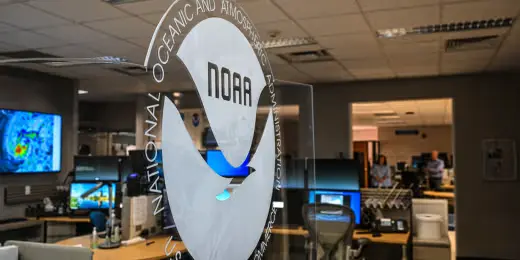Fired, Rehired, Then Fired Again: NOAA Employees Hit With Payback Demands in Bureaucratic Fallout

After being terminated, reinstated, and then dismissed again, some NOAA employees have now received federal letters demanding repayment of salaries. The chaotic personnel saga raises questions about accountability, management, and workers’ rights.
In a startling bureaucratic twist, a number of employees at the National Oceanic and Atmospheric Administration (NOAA) are finding themselves at the center of an administrative mess — one that has seen them fired, reinstated, fired again, and now saddled with unexpected debt. Several current and former workers have received official notices from the federal government demanding they repay thousands of dollars in wages, benefits, or severance they were previously paid, leaving careers and lives in turmoil. This complex episode reflects deeper issues within federal human resources management, agency oversight, and labor protection frameworks — all while impacting the people responsible for some of the government’s most vital scientific and environmental work. ### The Origins of the Chaos The situation dates back to a restructuring plan introduced under previous administrations to streamline operations within NOAA. The agency — which oversees critical services like weather forecasting, climate monitoring, and oceanic research — had been under internal review for staffing optimization. Several positions deemed redundant or budgetarily unsustainable were terminated in what officials initially described as a necessary but painful reduction. However, in a surprising move, some of these terminated employees were rehired just months later — often into similar roles — either because funding was unexpectedly restored, or due to the need for specialized skill sets that had proven difficult to replace. “It was a whirlwind,” said Maria Henderson, a marine data analyst who worked in NOAA’s fisheries division for over a decade. “I was told my job was gone. Then I was told I could come back. Then I was told I never should have returned. And now they want money back?” ### A Bureaucratic Backfire What followed was a bureaucratic nightmare. According to internal documents obtained by employee unions and shared with journalists, an internal audit triggered a formal review of rehiring procedures. It appears that in multiple instances, rehires were approved without proper authorization or misclassified in federal personnel systems. The result: once these discrepancies were discovered, a second wave of firings occurred — and now, affected employees are receiving formal debt collection letters demanding repayment of earnings the government claims were distributed in error. “Imagine being laid off, then asked to return and help during hurricane season, only to be let go again — and now told you owe tens of thousands of dollars?” said one former NOAA meteorologist, who asked to remain anonymous due to ongoing legal negotiations. ### How Much Money Is Being Demanded? Letters reviewed by reporters show repayment demands ranging from a few hundred dollars to more than $35,000. The amounts typically include salary paid during the contested rehiring period, any bonuses or cost-of-living adjustments applied, and in some cases, benefits such as health insurance and retirement contributions. According to the Office of Personnel Management (OPM), overpayment collections are not uncommon in the federal system. However, these usually stem from clerical errors or misreported time, not mass personnel management failures. “This is different,” said Richard Lyle, a labor law expert and former OPM official. “Here you have what appears to be systemic mismanagement, and employees who acted in good faith are being punished.” ### NOAA’s Response NOAA leadership has issued limited public comments on the matter, referring questions to the Department of Commerce, its parent agency. In a written statement, a Commerce spokesperson acknowledged that “a limited number of rehire actions were conducted without full procedural compliance” and that “a review is ongoing.” The agency also stated that employees who received repayment letters have the right to appeal and request a waiver if they can demonstrate hardship or lack of fault. But critics say that’s not enough. “These are scientists and technicians, not HR experts,” said Bethany Shaw, president of a NOAA employee union. “They relied on their supervisors and HR representatives to guide them through the process. Now they’re being punished for trusting their own agency.” ### The Human Toll For employees caught in the crossfire, the consequences are not just financial but deeply personal. Some say they’ve had to dip into retirement savings, put off medical care, or postpone home purchases due to the unexpected debt notices. “I’ve never owed anyone anything,” said Alan Royce, a coastal engineer based in Florida. “Now I’m being told I owe $22,000 — money I earned working 60-hour weeks during hurricane recovery efforts.” Others are suffering professional setbacks. Several say they’ve struggled to secure new jobs, as the unusual sequence of firings and rehirings has left blemishes on their federal employment records. “Private employers see the term ‘involuntary separation’ and hesitate,” said one NOAA data scientist. “It doesn’t matter that the whole thing was a mess — it follows you.” ### Legal Action on the Horizon Employee advocacy groups and federal unions are calling for congressional intervention. Several lawmakers, including members of the House Committee on Science, Space, and Technology, have reportedly requested briefings from NOAA leadership. In addition, legal action is being explored. At least three affected employees have retained legal counsel to file formal challenges to the repayment demands, citing due process violations and negligent administrative oversight. “There is a real question here about fairness and equity,” said employment attorney Rachel Kim, who represents two former NOAA employees. “If an agency makes a mistake, it should not be the individual employee who bears the cost.” ### Broader Implications for Federal Workers This situation highlights vulnerabilities in federal HR systems, particularly during periods of rapid transition or budget-driven restructuring. Critics argue that agencies often fail to provide clear guidance to employees or ensure procedural consistency across departments. “These aren’t isolated incidents,” said Lyle. “The federal government has thousands of job classifications, dozens of pay systems, and dozens of oversight bodies — the complexity itself is a problem.” Advocates are pushing for policy reforms, including: - Greater protection for employees rehired in good faith - Improved internal communication during layoffs and recalls - Automatic waivers for repayment when agency fault is evident - A cap on retroactive debt collection for administrative errors ### What’s Next? For now, affected NOAA employees are in limbo. Some are waiting for appeals to be processed. Others are considering early retirement, career changes, or even bankruptcy. And a growing number are speaking out — hoping that public pressure will push federal agencies to reverse course. In the meantime, unions are urging NOAA not to pursue repayment aggressively and to prioritize fairness over bureaucratic formality. “People who served this country with integrity — tracking storms, analyzing climate data, saving lives — deserve better,” said Shaw. “This isn’t just about money. It’s about how we treat public servants.” As more details emerge and pressure mounts on NOAA and the Commerce Department, the case could become a catalyst for long-overdue federal employment reform — and a cautionary tale about what happens when paperwork becomes punishment.



